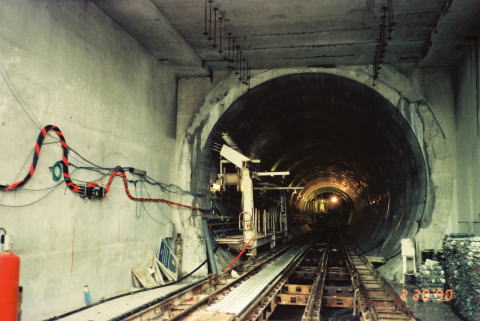 |
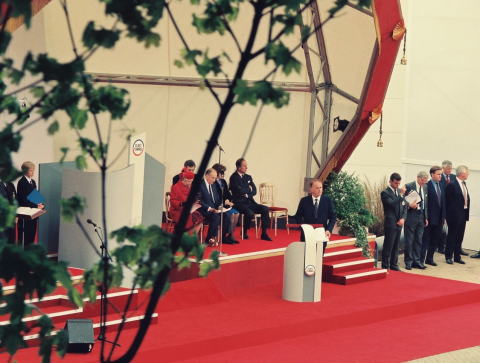 |
ü@Pictures above:Calais under construction visited in Feb.éPéXéXéO (left) and the Inauguration Ceremony at Folkestone on 6th. May 1994. Chairman Sir Alastair Morton going to give a speech. Her Majesty The Queen and The French President Mitterrand were sitting on the top stage behind.(right) ü@ü@ü@ü@
Preface
ü@ Japanese contribution to the channel tunnel project is not small. All the digging machines( shield-machines) were made in Japan and a group of Japanese engineers who had been engaged in Seikan Tunnel(a railway tunnel between Hokkaido and Honshu, completed in 1987) extended technical advice. On the fund raising side, share of Japanese banks amounted to nearly 25% in the beginning (though after several reschedules of loans they sold off their loans with deep discount).
ü@I am going to introduce the actual constrution site I visited and the inauguration ceremony I was invited, as a Japanese supporter to this great project who loved it and highly evaluated its role for promoting globalization and the welfare of mankind.
Brief History of the Channel Tunnel
ü@The idea to construct a land-continued passage across the English Channel can be dated back to fairly long ago. A French geologisit was said to propose it in 1753, under the reign of King Lewis ć]ćXüDA number of such ideas in the early years as a device for invading Britain from France had emerged and disappeared. 50years later, in 1802, Albert Mateieu, a French mining engineer presented to Napoleon Bonaparte an idea for two gas-lit tunnels, ventilated by chimneys, which would rise to a mid-point artificial island city, where horses could be changed. Napoleon approved this plan, but it was abandoned in 1805.
ü@Thome de Gamond, a great tunnel visionary, began his lifelong obsession to design cross-channel passage for a peaceful purpose in 1830. Some years later British visionaries such as John Hawkshaw followed. In 1880, work actually began on digging a tunnel but invasion fears caused the British prime minister William Gradstone to abandon it.
ü@In 1974, work began again but was soon abandoned because of the oil-crisis.
ü@In 1986, Prime Minister Margaret Thatcher and President Mitterrand signed the Treaty of Canterbury which marked the beginning of legistrative procedures. Necessary companies for the construction and operation such as Eurotunnel were incoroporated and Sir Alastair Morton and Andre Benard were appointed as co-chairmen. The first test shafts were begun on French side at Sangatte. In the next year, the UK service tunnel began from Shakespeare Cliff towards France.
ü@This time the work went on smoothly, and in Dec.1990, only a little more than 3 years after the beginning of the work, the undersea service tunnel met. For the first time in 12,000 years people can cross the Channel on foot.(Christmas card from the EuroTunnel to me:belowüjüB
ü@After further 3 and a half year, the Channel Tunnel was opened by the Queen and President Mitterrand at the inauguration ceremony on 6th.May 1994.
ü@
 |
ü@It is to be noted that such an unprecedentedly huge project of historical importance of the world had been completed at a surprising speed of in just 8 years, albeit the stage of just an idea had been long.
Backgrounds and the world historical meaning of the Channel Tunnel
ü@The period since the end of 1980's towards the beginning of 90's was, as you all know well, a historic turnig point of world political and economic regime.
ü@üinote) Looking back the world history carefully, you can notice that in every century after the 16th., a great or symbolic historic event had occured in the year whose last 2 numbers are 88 or 89.
ü@1588; Battle of Armada i.e. England became the world superpower pulling down Spain and Portugal.
ü@1688; Glorious Revolution, i.e. the start of constitutional monarchy in the world
ü@1789; French Revolution(no additional comment needed)
ü@1889; Japanese first Constitution i.e. the start of an Asian country joining into Western developed world. Also in Europe main actors of the World WarćTsuch as German Emperor WilliamćU appeared and the road to the War started to be paved.
ü@(again in the 20th. century, this coincidence repeated)
ü@1989; Oct. Berlin Wall collapsed, followed by German re-unification next year, establishment of EBRD in 1991 Apr. and collapse of Soviet Union in Dec., completion of EU single market from the beginning of 1993. All those lit Europian people's enthusiasm and expectation for the end of Cold War and the postwar tragic regime, for the unification of Europe and globalization.
ü@
ü@No doubt, the Channel Tunnel must be a most significant achievement representing such historic backgrounds at that time.
ü@It deserves high awards that the two nations at both sides that had experienced a long history of conflicts and wars, such as the 100year War, Spanish Succession War, Napoleon War and so on had cooperated each other to overcome immence political, social and financial difficulties(the techinical difficulty was not any more so hard as I introduce later), and made the long dream of the people of not only both countries but also the whole Europe come to true.
ü@
Visiting Calais Construction Siteü@
ü@In 1989 and 1900 when the coustruction work of the tunnel was at its peak, I was in charge of both bilateral and multilateral international financial cooperation to support those positive regime changes of the world, including economic reconstructions in Eastern European countries.
ü@Although I had nothing to do with the Channel Tunnel officially, I was strongly attracted by the project and even felt some excitement in it personally based on my recognition for its historic meaning. So, I had been seeking for the opportunity to witness it. Luckily enough, my wish was fulfilled and I was able to visit Calais site in Feb.1990.
üiPictures Below) Entrance of the office on the ground, there stand large dolls of King Henryć[ü@of England(front) and King FrancisćTof France, whom each people might be most proud of.
ü@
ü@As for the total underground length of the tunnel, Channel Tunnel is 49.2km, next to that of Seikan's 53.8km in the world ranking, but as for the length undersea, Channel is top 37.5km, longer than Seikan's 23.3km. Concerning technical difficulties, Seikan that was dug through fragile rocks with many bad faults and took 16 years acutual work must have been far more difficult than Channel.
ü@Under English ChannelüAa thick and solid blue-chalk layer covers the seabed with only a few faults. The work was to dig through the layer with the digging machines made in Japan. Since the surroudings are solid, concrete coting panels inside can be put on later.
üibelow left)
ü@A train of 8 open trucks comes back from the digging front(workface) to the large underground base carring clods of wet slippery blue chalk each as large as a basketball. Under the end of the railroad was a huge well whose diameter is just the same as the length of the full tarin. After the tarin has set on the wellüAthe rail is cut off, then the both ends of the train is fixed and the train with the rail is turned upside-down. After the whole contents of the trucks have fallen into the well, the train is turned back to the upright position, the rail connected again, and the train returns to the digging front.
üi4 picture below)
ü@Then water is poured into the well and stired, chalk turned into heavy
solution. It is pumped up through a pipeline to an artificial pond on the
hill in Calais. After several months, water pours through the dam and solid
land is reclaimed.What an idealistically efficient work it is!
üitop 2 pictures below.)
(following 4 are the Calais side entrances of two raiway tunnels and the service tunnel. And 2 in the bottom are inside of the half completed part I walkedüjüB
ü@
ü@This visit stired my enthusiasm for the project further more and I had volunteered to act as an opinion learder in Japan to personally advocate it even after I had changed my job.
Visiting Calais Construction Siteü@
ü@In 1989 and 1900 when the coustruction work of the tunnel was at its peak, I was in charge of both bilateral and multilateral international financial cooperation to support those positive regime changes of the world, including economic reconstructions in Eastern European countries.
ü@Although I had nothing to do with the Channel Tunnel officially, I was strongly attracted by the project and even felt some excitement in it personally based on my recognition for its historic meaning. So, I had been seeking for the opportunity to witness it. Luckily enough, my wish was fulfilled and I was able to visit Calais site in Feb.1990.
üiPictures Below) Entrance of the office on the ground, there stand large dolls of King Henryć[ü@of England(front) and King FrancisćTof France, whom each people might be most proud of.
ü@
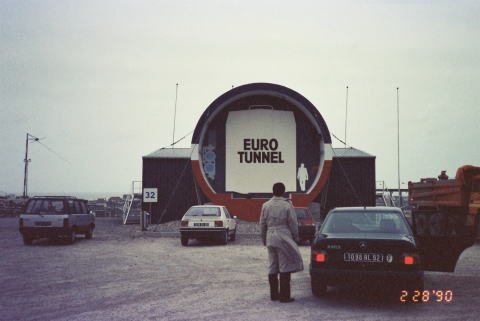 |
 |
ü@As for the total underground length of the tunnel, Channel Tunnel is 49.2km, next to that of Seikan's 53.8km in the world ranking, but as for the length undersea, Channel is top 37.5km, longer than Seikan's 23.3km. Concerning technical difficulties, Seikan that was dug through fragile rocks with many bad faults and took 16 years acutual work must have been far more difficult than Channel.
ü@Under English ChannelüAa thick and solid blue-chalk layer covers the seabed with only a few faults. The work was to dig through the layer with the digging machines made in Japan. Since the surroudings are solid, concrete coting panels inside can be put on later.
üibelow left)
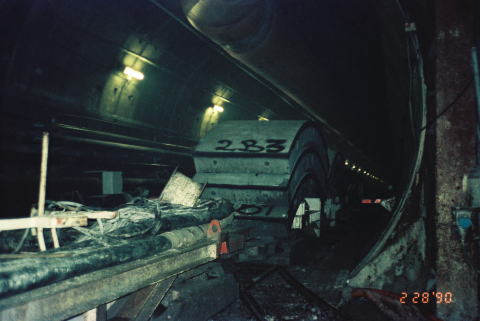 |
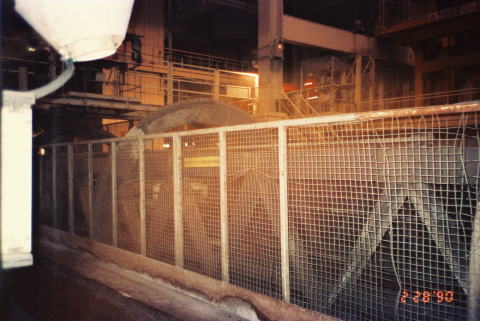 |
ü@A train of 8 open trucks comes back from the digging front(workface) to the large underground base carring clods of wet slippery blue chalk each as large as a basketball. Under the end of the railroad was a huge well whose diameter is just the same as the length of the full tarin. After the tarin has set on the wellüAthe rail is cut off, then the both ends of the train is fixed and the train with the rail is turned upside-down. After the whole contents of the trucks have fallen into the well, the train is turned back to the upright position, the rail connected again, and the train returns to the digging front.
üi4 picture below)
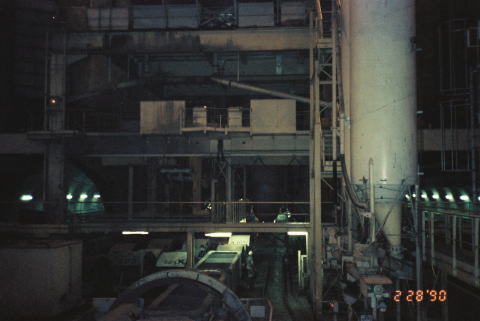 |
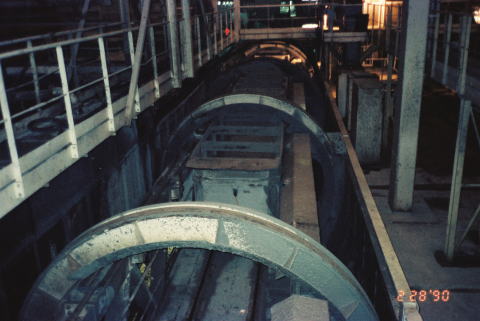 |
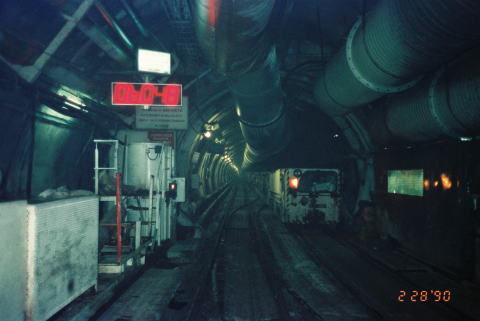 |
 |
üitop 2 pictures below.)
(following 4 are the Calais side entrances of two raiway tunnels and the service tunnel. And 2 in the bottom are inside of the half completed part I walkedüjüB
ü@
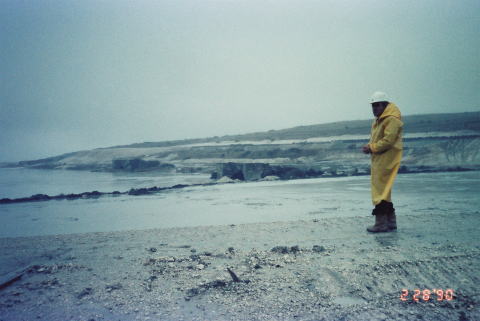 |
 |
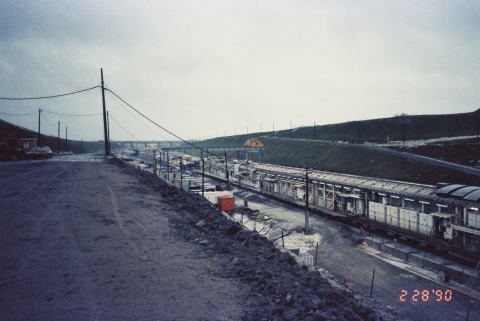 |
 |
 |
 |
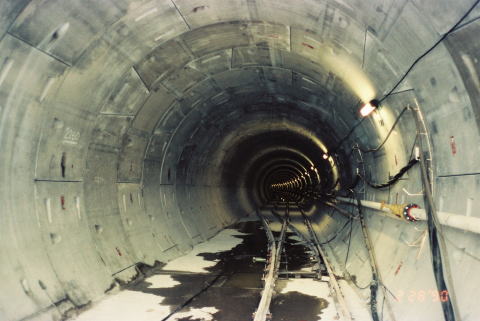 |
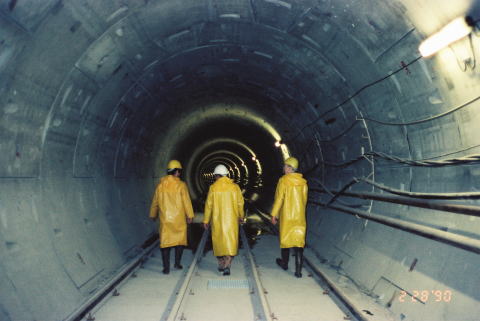 |
ü@This visit stired my enthusiasm for the project further more and I had volunteered to act as an opinion learder in Japan to personally advocate it even after I had changed my job.
Invited to the Inauguration Ceremony ü@
ü@4 years later, on one day in Apr. 1994, an invitation card of a solemn style with the names of the Queen and the President was sent to me.(the picture below left)
It was a delightful surprise for me. Being a mere ordinary Japanese citizen then, I felt it as a most memorable honour and decided to attend from Japan at my own expense.
 |
ü@The ceremomy was a whole day magnificent fesitival starting at Calais at first and then in Folkestone.
ü@In case of Folkestone site I was invited, I was requested to arrive at Victoria Station by 8:30 at the latest and to make way to heavily guarded Platform 2 where the train "Folkestone Special" stayed. At the ticket barrier I showed the special train ticket sent to me with the confirmation of invitation and proceeded to my carriage indicated. In front of the carriage, stuff accredited me by the invitation card and my passport number registered beforehand.
ü@After the accreditation was safely over, I was given a set of documents such as itinerary of the ceremony and my name badge and fianally ushered to the train.(pictures below)
 |
 |
ü@The special train departed at 8:51 sharp as in the instruction(quite unusual for the British Rail at that time). A number of dressed up ladies and gentlemen from all over the coutryside who could be identified as " Mr. or Ms. Shareholder" by their badges chatted cheerfully in the tarin.
ü@In commercial operation, shattle trains carrying cars go between two terminal stations on both sides of the Channel, Calais and Folkestone, which are built at the ends of the branch lines divided from the main line in the tunnel. Whereas Eurostars, through trains beween London Waterloo and Paris, go strait through the main line without passing the terminals.
ü@After one and a half hour from the departure our special train went into the tunnel beyond the swich-back point. Then the rail-point was shifted and the train went back into the Folkestone Terminal platform.
ü@Passengers were carried from the platform to the huge tent near the passengers' terminal by dozens of coaches. üibelow top leftüj On our way, we saw the Eurostar from Waterloo on which the Queen and other VIPs rode going into the tunnel for Calais.
ü@In the tent, 155 tables for 10 seats each were set surrounding the stage in the centre.(below right 2 pictures) Sitting at the table we wait for the start drinking champagne from 10:30 a.m., listening to the music by the orchestra on the stage. (below down left: at table 136 former permanent secretay of HM Treasury Sir Douglas Wass to the left and myself to the right)
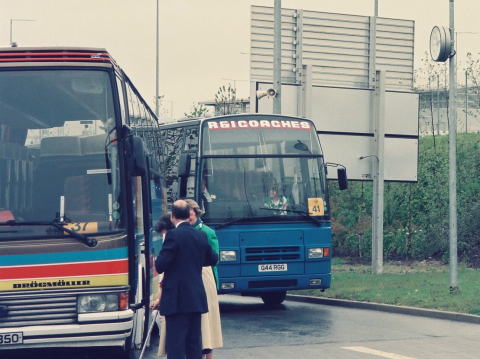 |
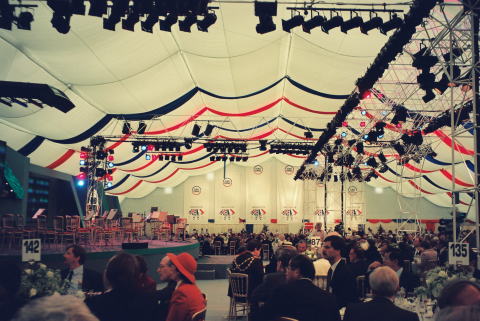 |
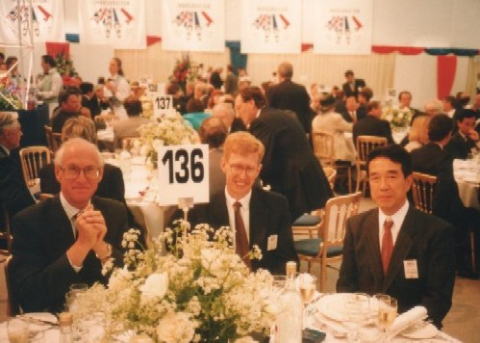 |
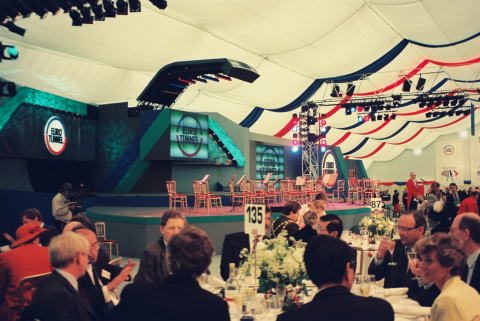 |
ü@After one hour or so, the scene at Calais Terminal was displayed on the huge screen of 25 panels on the stage. One train from Paris with President Mitterrand and the the other with the Queen from London arrived at the same time. The ceremony started by the President welcoming the Queen. The speech by the Queen here in France was in French.(4 pictures below)
ü@
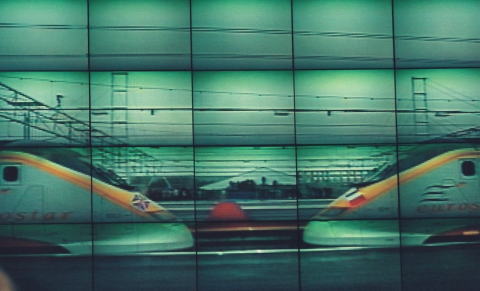 |
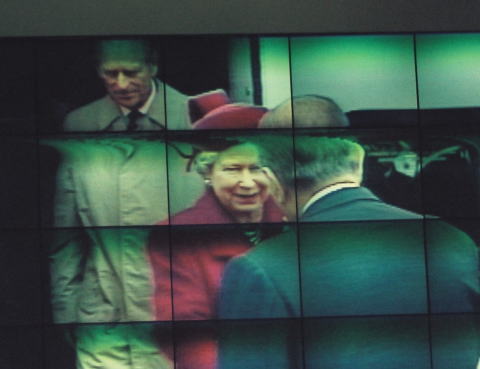 |
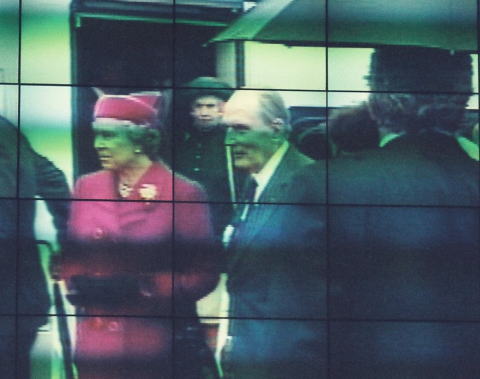 |
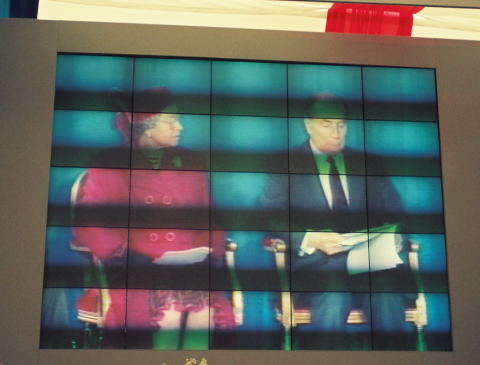 |
ü@After the ceremony, luncheon started on both sides. The menu of British side is, as shown below left, an patriotic menu consisted of representing British foods from various part of the country.
ü@Drinks could not be made in Britain only, still one English red wine branded
"Denbies Pinot Gris" was there. I was interested in the French
wine "Chateau La Tonnelle" in the menu wondering whether it is
a humor from an association with "tunnel", but I am not sure
until now.
ü@
ü@After the luncheon, we moved by coaches to the large temporary stand on the Folkestone platform and waited for the arrival of the Queen and the President in the opposite platform.(2 pictures below)
ü@
ü@Then the Eurostar pulling shattles for large cars slowly arrived and the Rolls Royce on which both heads of states rode appeared on the platform. They got off and shaked hands with the people related to the project. In the air, squadrons of British Air Force's Tornado, Harriar and Hercules demonstrated celebration flights.üi6 pictures belowüj
ü@
ü@After the welcoming was over all moved to the main stage next to the luncheon tent. (top left and second left and right of 4 pictures below) When Lady Thatcher dressed in a black robe wearing a hard white strawhat sat on her seat at the main stand in front of the stage, large applause continued. Certainly she was the greatest person of merit to this project.(top right)
ü@
ü@The main ceremony had started by Sir Alastair Morton' s speech saying " Her Majesty the Queen ElizabethćU is the first English sovereign who went there and back under the English Channel alive" that was awarded by great applauseüipicture right of the 2 pictures on the top of this pageüj, followed by speeches by the Queen this time in English and by the President again in French which sounded rather political. Then they uncoverd the monument and the ceremony successfully ended.
ü@Then we got back to the previous tent and enjoyed a luxurious traditional English afternoon tea.üimenu is shown to the right of the luncheon menu shown beforeüj After the tea we came back to Victoria station by the same special train at 7 p.m. and the wholeday festival was over.
ü@By the way, one impressive point to be noted is the diiference of the temperature or enthusiasm to this event of the peoples of the two countries on both sides which I perceived in walking around London and Paris.
ü@On French side, TV or newspaper reports were enthusiastic and celebrating on this historic event, whereas in London, they were calm and cool. I could find any "Eurotunnel souvenir" nowhere even around Waterloo station.ü@Even in the morning of the inauguration day, British TV provided such a special programme that rabies which has been extinguished in Britain might be carried by rats through the tunnel. Delay in the inland railway improvement in English side would have been another example of such mentality.
ü@However, I believed that British people would soon come to recognize the benefit of the tunnel and appreciate it as an indispensable infrastruture for the whole Europe.
ü@Depite the glorious inauguration introduced here, environments surrouding Eurotunnel had not been favourable at all. In addition to the unfortunate fire accident, financial diificuties continued for a long time and there had been shareholders' revolts.
ü@However, the prophecy on the first page of the invitation document(to the right of the invitation card before shown) "In the months and years to come we believe people will wonder 'how did we ever do without it?' as the Channel is no longer an obsacle between our two countries" came true soon after the start of the commercial operation.
ü@I believe firimly that the Channel Tunnel is a great fruit of the wisdom and decisiveness of the farsighted people in political, economic and technical fields. Also I consider it as a symbol of the new era of globalization and unification of Europe aiming the welfare of the whole people in the world.
Thanking my good luck to follow such a thrilling project from a remote place, depite for a short while.
(written in June 2004, rivised in Dec. 2019)
ü@
 |
ü@After the luncheon, we moved by coaches to the large temporary stand on the Folkestone platform and waited for the arrival of the Queen and the President in the opposite platform.(2 pictures below)
ü@
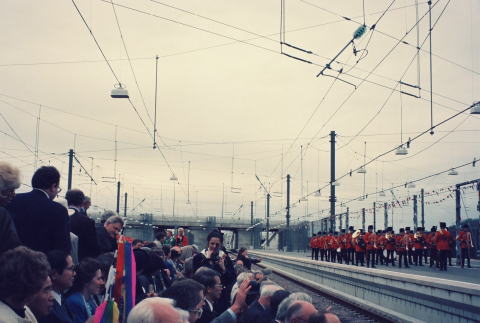 |
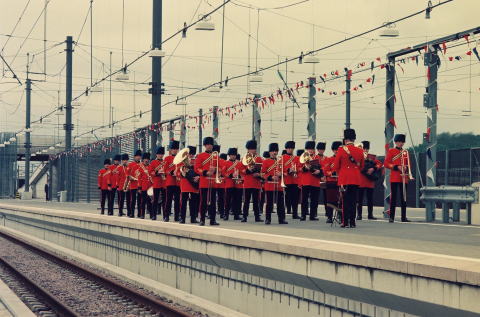 |
ü@Then the Eurostar pulling shattles for large cars slowly arrived and the Rolls Royce on which both heads of states rode appeared on the platform. They got off and shaked hands with the people related to the project. In the air, squadrons of British Air Force's Tornado, Harriar and Hercules demonstrated celebration flights.üi6 pictures belowüj
ü@
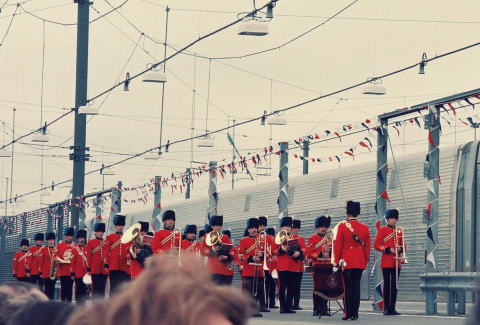 |
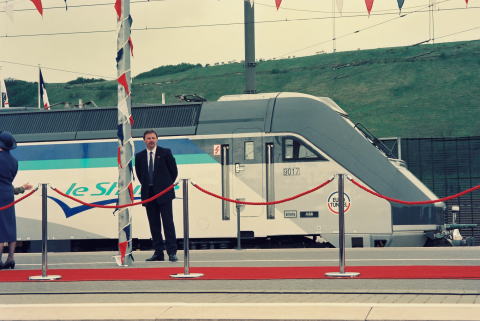 |
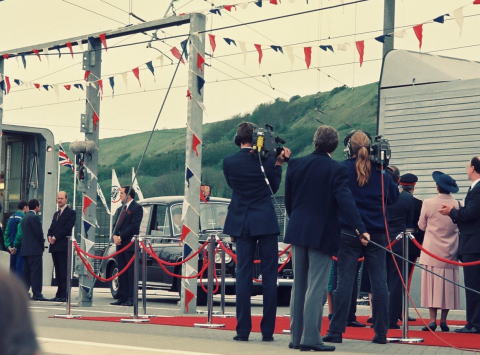 |
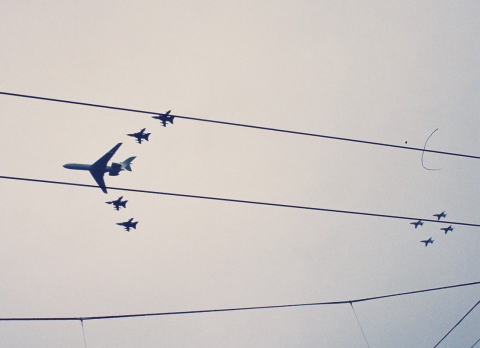 |
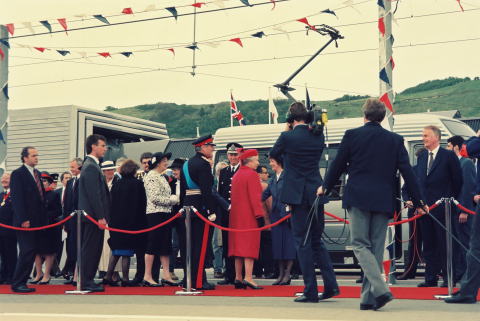 |
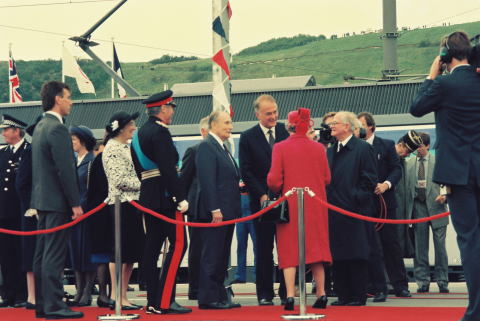 |
ü@After the welcoming was over all moved to the main stage next to the luncheon tent. (top left and second left and right of 4 pictures below) When Lady Thatcher dressed in a black robe wearing a hard white strawhat sat on her seat at the main stand in front of the stage, large applause continued. Certainly she was the greatest person of merit to this project.(top right)
ü@
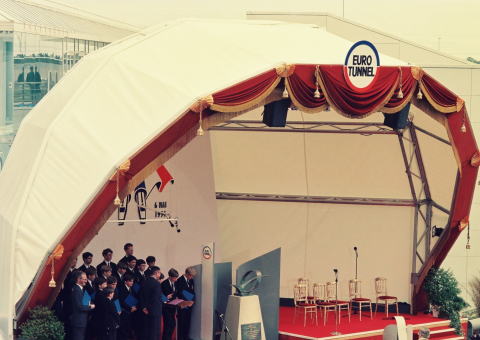 |
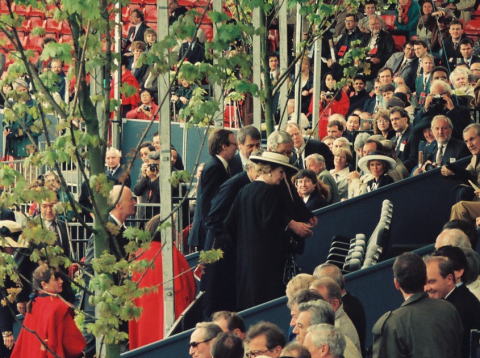 |
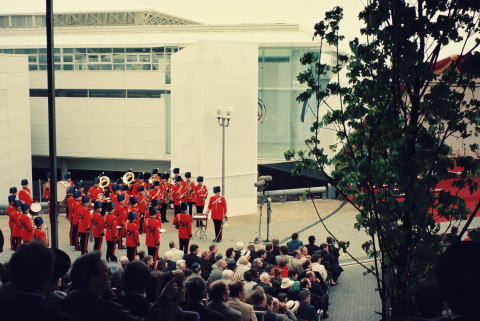 |
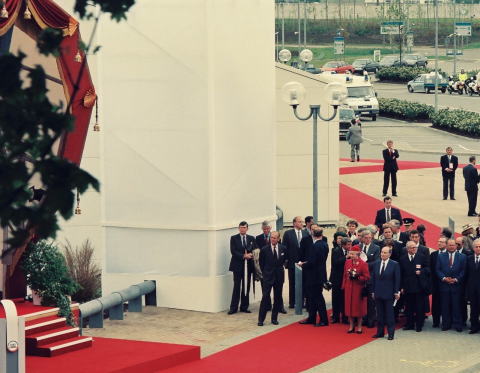 |
ü@The main ceremony had started by Sir Alastair Morton' s speech saying " Her Majesty the Queen ElizabethćU is the first English sovereign who went there and back under the English Channel alive" that was awarded by great applauseüipicture right of the 2 pictures on the top of this pageüj, followed by speeches by the Queen this time in English and by the President again in French which sounded rather political. Then they uncoverd the monument and the ceremony successfully ended.
ü@Then we got back to the previous tent and enjoyed a luxurious traditional English afternoon tea.üimenu is shown to the right of the luncheon menu shown beforeüj After the tea we came back to Victoria station by the same special train at 7 p.m. and the wholeday festival was over.
ü@By the way, one impressive point to be noted is the diiference of the temperature or enthusiasm to this event of the peoples of the two countries on both sides which I perceived in walking around London and Paris.
ü@On French side, TV or newspaper reports were enthusiastic and celebrating on this historic event, whereas in London, they were calm and cool. I could find any "Eurotunnel souvenir" nowhere even around Waterloo station.ü@Even in the morning of the inauguration day, British TV provided such a special programme that rabies which has been extinguished in Britain might be carried by rats through the tunnel. Delay in the inland railway improvement in English side would have been another example of such mentality.
ü@However, I believed that British people would soon come to recognize the benefit of the tunnel and appreciate it as an indispensable infrastruture for the whole Europe.
ü@Depite the glorious inauguration introduced here, environments surrouding Eurotunnel had not been favourable at all. In addition to the unfortunate fire accident, financial diificuties continued for a long time and there had been shareholders' revolts.
ü@However, the prophecy on the first page of the invitation document(to the right of the invitation card before shown) "In the months and years to come we believe people will wonder 'how did we ever do without it?' as the Channel is no longer an obsacle between our two countries" came true soon after the start of the commercial operation.
ü@I believe firimly that the Channel Tunnel is a great fruit of the wisdom and decisiveness of the farsighted people in political, economic and technical fields. Also I consider it as a symbol of the new era of globalization and unification of Europe aiming the welfare of the whole people in the world.
Thanking my good luck to follow such a thrilling project from a remote place, depite for a short while.
(written in June 2004, rivised in Dec. 2019)
ü@ü@ü@æOé╠āyü[āWéų¢▀éķüiBack to theü@éoéÆéģé¢éēéÅéĢéōü@éoéüéćéģüj